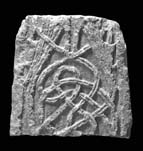Select a site alphabetically from the choices shown in the box below. Alternatively, browse sculptural examples using the Forward/Back buttons.
Chapters for this volume, along with copies of original in-text images, are available here.
Object type: Part of a cross-shaft
Measurements: H. 43 cm (16.7 in); W. 39 > 34.9 cm (15.3 > 13.7 in); D. 31.5 > 28 cm (12.4 > 11 in)
Stone type: Yellowish grey (5Y 8/1) grain supported oolite with ooliths mainly around 0.5 mm in size. Cleeve Cloud Member, Birdlip Limestone Formation, Inferior Oolite Group, Middle Jurassic.
Plate numbers in printed volume: Ills. 274-7; Figs. 17, 24E, 27C
Corpus volume reference: Vol 10 p. 208
(There may be more views or larger images available for this item. Click on the thumbnail image to view.)
There is a plain flat edge moulding on all four faces.
A (broad): The feet of two facing peacocks? stand on a loose median-incised interlace that has developed from their long tails.
B (narrow): This carries a development of the median-incised vine-scroll, in which the volutes have become overwhelmed by a tangle of knotted tendrils.
C (broad): Badly damaged, but the remains of irregular, median-incised interlace survive in what may be two blocks either side of a centre line.
D (narrow): A tight, rather irregular four-strand, median-incised pattern F interlace covers the whole face.
Some of the elements on Gloucester St Oswald 1, such as the paired birds and the hook-tipped triangular leaves, are used again on St Oswald 2. The treatment of the vine-scroll, however, must indicate that the cross is a little later in date. Gone is the classical simplicity of the inhabited vine of St Oswald 1 and in its place is rampant and unpruned disorder, in which writhing tendrils have grown around the main volutes. Errors in the layout of the carpet of interlace on face D suggest that the carver had ideas that were greater than his abilities. A date towards the end of the eighth century would be appropriate for this cross.



